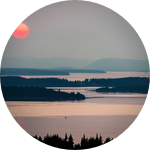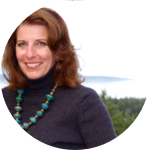About This Project
Research Now generates best available science to inform policy decisions.Research Now proposes a scientific investigation of two recently discovered faults, Skipjack Island and Sandy Point. New knowledge will lead to better understanding of seismic hazards near the proposed Gateway Pacific Terminal site at Cherry Point, WA -- near the US-Canadian border. If built, it would be the largest coal transport facility in North America.
Ask the Scientists
Join The DiscussionWhat is the context of this research?
Major increases in maritime activity are being proposed for the Salish Sea from Vancouver, BC, to Bellingham, WA, entailing construction of rail-to-ship coal storage and transfer facilities. We are evaluating these projects to inform local and regional government agencies so that they can properly assess and manage them.Research Now is providing seed funding of $5,000 for this research project to generate best available science for use in policy decisions pertaining to the Gateway Pacific Terminal at Cherry Point, WA.Research Now supports this investigation because it will lead to better understanding of seismic hazards near the proposed coal transport site that could adversely affect this facility and potentially lead to economic and ecological disaster.See research-now.org/our-pilot/
What is the significance of this project?
This project
- Is timely and time sensitive. It will generate best available science about seismic hazards to inform local, state and national policy decisions related to the Gateway Pacific Terminal at Cherry Point, WA that likely will be made within the next 18 months.
- Is important. The proposed GPT would ship >54 million tons of thermal coal annually through the Salish Sea to Asian markets. Hundreds of communities from coal pit to coal port are impacted by decisions made about this terminal.
- Fills significant research gaps. This focused study is needed to understand the seismic hazards near this site.
- Cannot be funded any other timely way, because no federal, state or private mechanisms exist to do so.
- Has high stakes. Best available science is needed to inform the best possible decisions.
What are the goals of the project?
Goal: To better characterize two recently discovered faults near Cherry Point: The Skipjack Island fault that trends W-E from South Pender Island in Canada, to north of Orcas Island, WA, and the Sandy Point fault in the area just west of Cherry Point. Since quake magnitude increases with fault length, one must determine the full extent of these faults to properly design for seismic hazards.Marine bathymetric and sub-bottom imagery as well as sediment samples will be collected by an experienced team of US and Canadian scientists. The data will be used to determine potential seismic hazards in the immediate area and to inform the public of local geologic conditions. Collected data will also be useful in developing a baseline to compare present seafloor conditions with future conditions.
Budget
We seek funding for a scientific investigation leading to better understanding of seismic hazards near the proposed Gateway Pacific Terminal site at Cherry Point, WA. Little is known of two recently discovered faults near that site. The Skipjack Island fault trends E-W from South Pender Island in Canada, to north of Orcas Island. The fault's eastern extent is unknown, especially in the region from north of Lummi Island east to the mainland. Similarly, the extent of the Sandy Point Fault in the area just west of Cherry Point is not known.
Research will be conducted by an experienced team of US and Canadian scientists--using bathymetric and sub-bottom imagery, as well as sediment samples--to measure the extent of the faults and character of the seafloor north and east of Lummi Island.
No federal, state or private funding mechanisms exist to support this kind of much-needed research in timely way to inform policy/permitting decisions.
Research results will be communicated to policy makers.
Meet the Team
Team Bio
Dr. Greene's geological oceanographic research is focused on tectonic and sedimentary processes that shape the coast and play a role in the evolution of submarine canyons. Of particular interest is the origin and movement of mass wasting events that have the ability to generate tsunami. Research undertaken at the Center for Habitat Studies entails the use of geophysical techniques in imaging the seafloor and constructing potential habitat maps that are useful in managing bottom fisheries.Dr. Greene's recent collaborations with a team of Canadian scientists using side-scan sonar to map the seafloor in the Salish Sea around the San Juan Islands enable him to lead this study that will result in unique and important contributions to our understanding of seismic hazards at Cherry Point, WA.
Ms. Riordan built on 25 years of experience at the intersection of science and policy to found Research Now as a new way to identify and generate best available science for policy makers.
Research Now
Research Now exists to generate best available science to inform policy decisions.
Why do we exist? Because as citizens, we have a reason expectation that policy makers use best available science when they make decisions that affect us in communities across the nation. If there are gaps in best available science, we can use powerful new tools -- like crowd funding -- to fund the research needed to fill knowledge gaps in a timely way.
Donna Gerardi Riordan
I moved to Orcas Island, Washington four years ago with no thoughts of starting a new research organization. However, in early 2012, I learned about plans to build the largest coal transport facility in North America – the Gateway Pacific Terminal – at Cherry Point, Washington, a short distance across Georgia Strait from Orcas, my new home. A review of the massive (and historic) scoping record for GPT revealed a lack of specific information needed to answer important scientific questions. So, building on 25 years of experience in science and technology policy and communications in the other Washington (DC) and in California, I founded Research Now with the goal of crowd funding location-specific research to inform policymakers. When I'm not talking about Research Now with anyone who will listen, I can be found with my very tolerant husband and son on beautiful Orcas Island.
Additional Information
Here is an example of the 1:20,000 scale maps we are constructing showing areas of no data (white areas) and any data we collect for this project will be used to fill in these white areas.
Project Backers
- 44Backers
- 100%Funded
- $50,000Total Donations
- $1,022.73Average Donation

